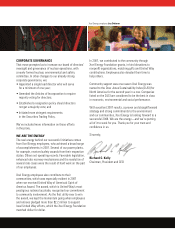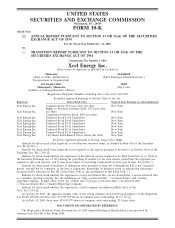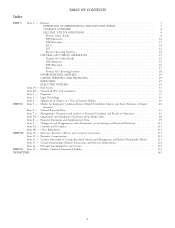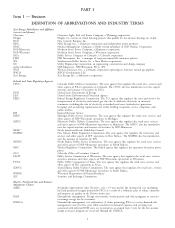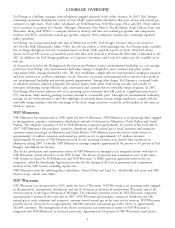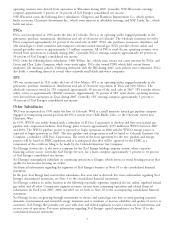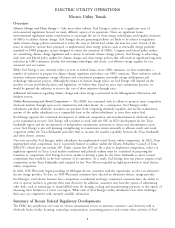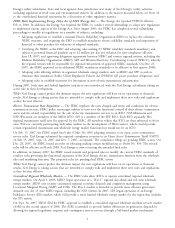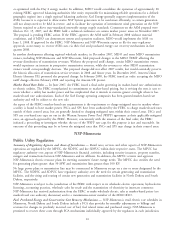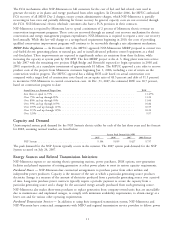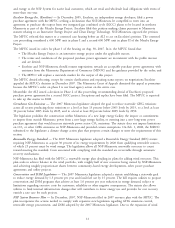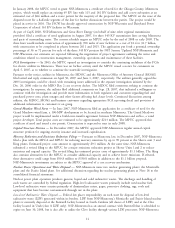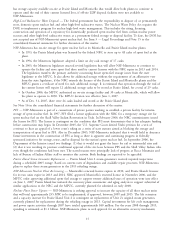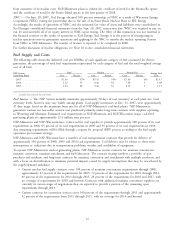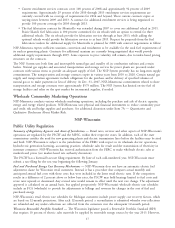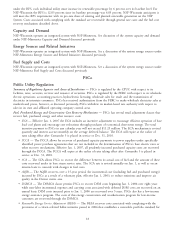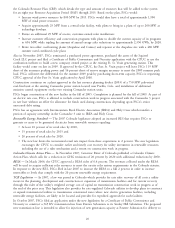Xcel Energy 2007 Annual Report Download - page 20
Download and view the complete annual report
Please find page 20 of the 2007 Xcel Energy annual report below. You can navigate through the pages in the report by either clicking on the pages listed below, or by using the keyword search tool below to find specific information within the annual report.co-optimized with the Day 2 energy market. In addition, MISO would consolidate the operation of approximately 20
existing NERC approved balancing authorities (the entity responsible for maintaining reliable operations for a defined
geographic region) into a single regional balancing authority. Xcel Energy generally supports implementation of the
ASM, because it is expected to allow native NSP System generation to be used more efficiently, as certain generation
will not always need to be held in reserve, and to facilitate the operation of intermittent wind generation on the NSP
System required to achieve state-mandated renewable energy supply standards. Comments on the ASM proposal were
filed on Oct. 15, 2007, and the FERC held a technical conference on certain market power issues in November 2007.
The proposal is pending FERC action. If the FERC approves the ASM tariff in February 2008 without material
conditions, and if MISO can demonstrate system and operation readiness, MISO would implement the ASM on
June 1, 2008. If approved by the FERC, NSP-Minnesota and NSP-Wisconsin expect to file for state regulatory
approvals, as necessary, to recover ASM costs via their fuel and purchased energy cost recovery mechanisms in first
quarter 2008.
In another development affecting regional wholesale markets, in December 2007, MISO and some MISO transmission
owners, including NSP-Minnesota and NSP-Wisconsin, filed proposed changes to the MISO TEMT affecting the
revenue distribution of transmission revenues. Without the proposed tariff change, certain MISO transmission owners
would experience an increase in prospective transmission revenues, while the revenues to other MISO transmission
owners would correspondingly decrease. The proposed change did not affect 2007 results, but would essentially preserve
the historic allocation of transmission service revenues in 2008 and future years. In December 2007, Ameren-Union
Electric (Ameren UE) protested the proposed change. In February 2008, the FERC issued an order accepting the MISO
tariff change effective February 2008 and rejecting the Ameren-UE protest.
Market Based Rate Rules — In June 2007, the FERC issued a final order governing its market-based rate authorizations
to electric utilities. The FERC reemphasized its commitment to market-based pricing, but is revising the tests it uses to
assess whether a utility has market power and has emphasized that it intends to exercise greater oversight where it has
market-based rate authorizations. Each of the Xcel Energy operating companies has been granted market-based rate
authority and will be subject to the new rule.
An aspect of the FERC’s market-based rate requirements is the requirement to charge mitigated rates in markets where
a utility is found to have market power. PSCo and SPS have been authorized by the FERC to charge market-based rates
outside of their control areas, but are generally limited to charging mitigated rates within their control areas. PSCo and
SPS use cost-based rate caps set out in the Western Systems Power Pool (WSPP) agreement as their applicable mitigated
rates, an approach approved by the FERC. However, concurrently with the issuance of the final order, the FERC
initiated a proceeding to investigate whether the use of the WSPP rate caps for this purpose is just and reasonable. An
outcome of this proceeding may be to lower the mitigated rates that PSCo and SPS may charge in their control areas.
NSP-Minnesota
Public Utility Regulation
Summary of Regulatory Agencies and Areas of Jurisdiction — Retail rates, services and other aspects of NSP-Minnesota’s
operations are regulated by the MPUC, the NDPSC and the SDPUC within their respective states. The MPUC has
regulatory authority over aspects of NSP-Minnesota’s financial activities, including security issuances, property transfers,
mergers and transactions between NSP-Minnesota and its affiliates. In addition, the MPUC reviews and approves
NSP-Minnesota’s electric resource plans for meeting customers’ future energy needs. The MPUC also certifies the need
for generating plants greater than 50 MW and transmission lines greater than 100 KV.
No large power plant or transmission line may be constructed in Minnesota except on a site or route designated by the
MPUC. The NDPSC and SDPUC have regulatory authority over the need for certain generating and transmission
facilities, and the siting and routing of certain new generation and transmission facilities in North Dakota and South
Dakota, respectively.
NSP-Minnesota is subject to the jurisdiction of the FERC with respect to its wholesale electric operations, hydroelectric
licensing, accounting practices, wholesale sales for resale and the transmission of electricity in interstate commerce.
NSP-Minnesota has received authorization from the FERC to make wholesale electric sales at market-based prices (see
market-based rate authority discussion) and is a transmission-owner member of the MISO RTO.
Fuel, Purchased Energy and Conservation Cost Recovery Mechanisms — NSP-Minnesota’s retail electric rate schedules in
Minnesota, North Dakota and South Dakota include a FCA that provides for monthly adjustments to billings and
revenues for changes in prudently incurred cost of fuel, fuel related items and purchased energy. NSP-Minnesota is
permitted to recover these costs through FCA mechanisms individually approved by the regulators in each jurisdiction.
10


